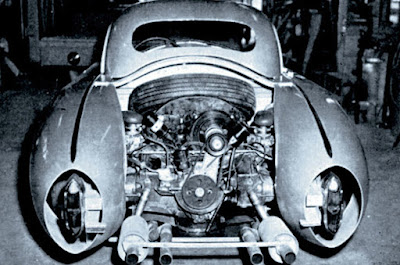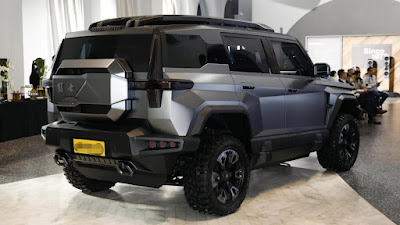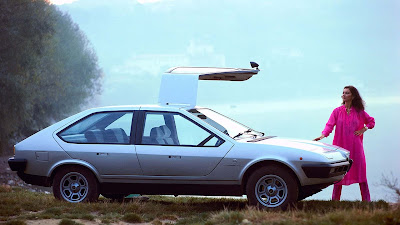Forgotten Icons - Louis J. Fageol from Cleveland, Ohio, internationally known as Lou Fageol left an indelible mark on the world of racing with his Porsche innovative and daring creations. While Porsche enthusiasts often marvel at the evolution of the brand's iconic sports cars, it's figures like Fageol who add a touch of rebellious flair to the narrative.
 |
| Lou Fageol's second radical twin-engined Porsche constructed from airplane drop tanks on a box channel frame with Porsche suspension bits, while attended at Pebble Beach April 1955 shows. (Picture from: JustACarGuy) |
Fageol's journey into automotive notoriety began with his fascination for dual-engine setups. This obsession stemmed from his father's legacy, Frank Fageol, was a co-founder of the Fageol Motors Company (along with his brother William) whose pioneered the concept of twin-engine buses in the early 20th century.
 |
| The original Fageol's car with 356 coupe body and '51-2 Packard grille in early August 1953 at Paine Field in Everett, Washington, during SCCA races held as part of the annual Seattle Seafair celebration. (Picture from: JustACarGuy) |
Among Frank's notable achievements was the development of a twin-engined bus, which he sold under the Twin Coach Company name. This familial connection to engineering excellence laid the groundwork for Lou's audacious experiments with Porsche cars.
 |
| Lou Fageol's second radical twin-engined Porsche with a flip top entry while raced at the 400 km race of Albany, and finished second with the unlimited class all-wheel-drive sports car. (Picture from: JustACarGuy) |
One of Lou Fageol's most striking creations was the Twin-engined Porsche racer. Unlike anything seen before, these cars were a testament to Fageol's ingenuity and willingness to push boundaries. The idea of marrying two Porsche engines to enhance performance was both bold and brilliant.
 |
| Lou Fageol's second radical twin-engined Porsche racer with a small sided, and flip top entries. (Picture from: JustACarGuy) |
The impact of Fageol's creations reverberated through racing circuits, where they earned a reputation for intimidating even seasoned competitors. His dual-engine Porsche not only showcased technical prowess but also hinted at the future of four-wheel-drive sports cars.
 |
| Interior view of Lou Fageol's second radical twin-engined Porsche. (Picture from: JustACarGuy) |
Fageol's innovations didn't stop there. He continued to refine his designs, culminating in a second car featuring a lightweight pipe frame and aluminum body—a true embodiment of racing aesthetics fused with engineering excellence. This car, powered by two Porsche 1500 Super engines, marked a pinnacle in Fageol's career.
 |
| Lou Fageol's second radical twin-engined Porsche powered by two Porsche 1500 Super engines (in pictured was its front engine), marked a pinnacle in Fageol's career. (Picture from: JustACarGuy) |
One notable event that highlighted the capabilities of Fageol's creations was the 400 km race in Albany, where his all-wheel-drive sports car secured a commendable second-place finish. The car's design, reminiscent of Pininfarina prototypes, underscored Fageol's ability to blend performance with aesthetics seamlessly.
 |
| Lou Fageol's second radical twin-engined Porsche powered by two Porsche 1500 Super engines (in pictured was its rear engine), marked a pinnacle in Fageol's career. (Picture from: JustACarGuy) |
Despite the passage of time, the legacy of Lou Fageol lives on in the annals of automotive history. His pioneering spirit and relentless pursuit of innovation continue to inspire generations of engineers and enthusiasts alike. Fageol's contributions to the evolution of Porsche racing remain a testament to the enduring allure of pushing boundaries and redefining what's possible on the track.
 |
| Lou Fageol's radical twin-engined Porsche featuring a lightweight pipe frame and aluminum body—a true embodiment of racing aesthetics fused with engineering excellence. (Picture from: JustACarGuy) |
 In retrospect, Lou Fageol's journey serves as a reminder that true innovation knows no bounds. As we celebrate the legacy of Porsche and its trailblazers, let us not forget the mavericks like Fageol, whose passion and daring paved the way for the remarkable machines we admire today. *** [EKA | FROM VARIOUS SOURCES | EXCELLENCE-MAG | ZWISCHENGAS | JUSTACARGUY | JALOPNIK | RESERVATORY6 ]
In retrospect, Lou Fageol's journey serves as a reminder that true innovation knows no bounds. As we celebrate the legacy of Porsche and its trailblazers, let us not forget the mavericks like Fageol, whose passion and daring paved the way for the remarkable machines we admire today. *** [EKA | FROM VARIOUS SOURCES | EXCELLENCE-MAG | ZWISCHENGAS | JUSTACARGUY | JALOPNIK | RESERVATORY6 ] Note: This blog can be accessed via your smart phone.





































